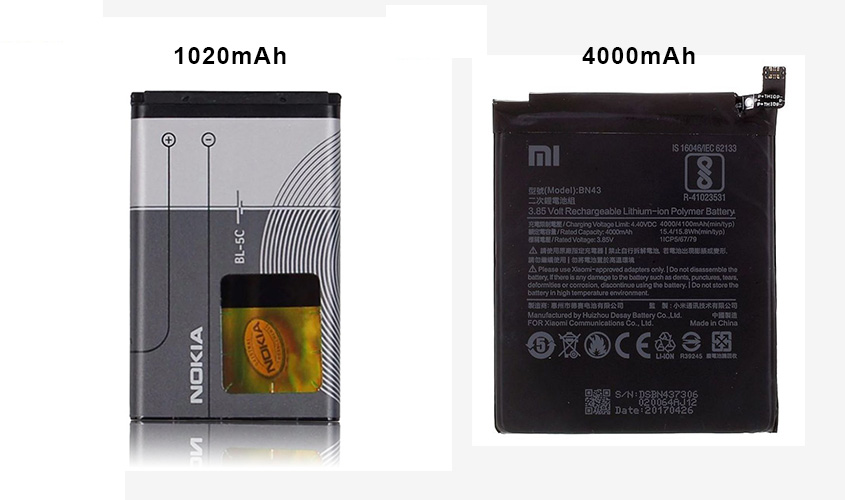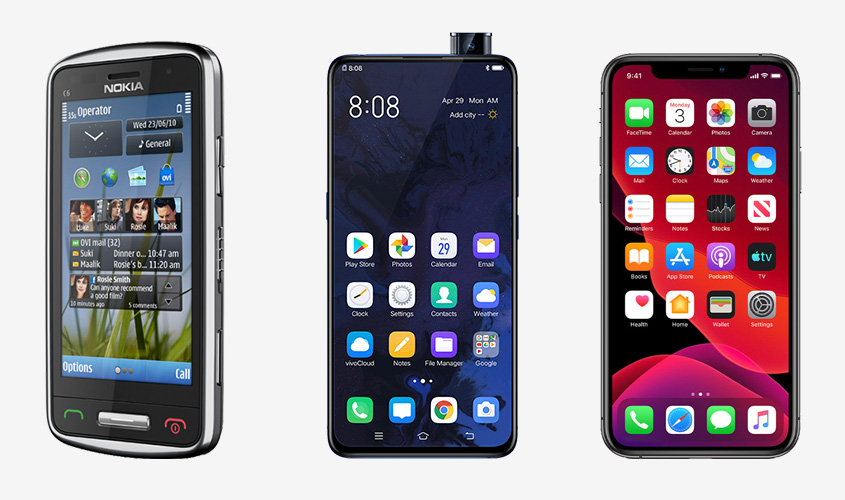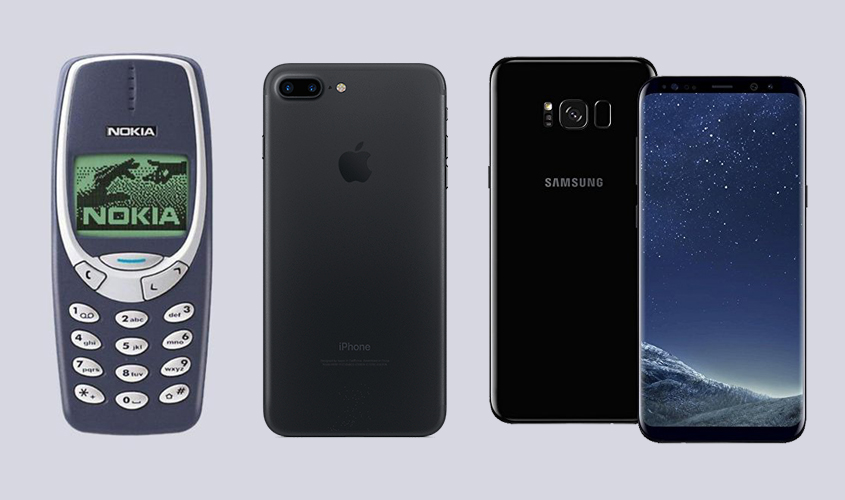The year 2020 is here, this not only marks the end of 2019, it also marks the start of a new year, a new decade, and a new revolution. Looking back to the decade, we got to see many major changes in the tech industry. We have come a long way in technology. Phone technology is one of them, with much more functions and feature changes. Here are some of the changes that took place in tech during the decade.
3.5 inch display to 6 inch or above display phones.
2010 was the year when Apple came up with iPhone 4. The phone had a 3.5-inch display, not only Apple many other phone manufacturers were using similar-sized display in their phones, fast forward 10 years, almost all the mobile phones have display size of 6 inches or above.
10 years ago, no one would have expected that the size of the phones and the size of the phone display would increase so dramatically. If we calculate per year growth in display sizes, it comes out to around 0.25-inch increase in display size per year during this decade.

60 hertz refresh rate to 90/120 hertz refresh rate.
Phone display size is not the only thing that changed in the last 10 years, other thing that changed was the rate of refresh, display does per second.
What is refresh rate?
The refresh rate is the number of times in a second that display hardware updates its buffer. This is distinct from the measure of frame rate which means updating with new data. The refresh rate includes the repeated drawing of identical frames, while frame rate measures how often a video source can feed an entire frame of new data to a display.
Many display still uses 60 hertz refresh rate but many display has started to implement higher refresh rate for smoother transitions. Many displays are shifting from 60 hertz refresh rate to 90 or 120hertz refresh rate which provides smoother transition and overall better viewing experience.
Battery size
There is no denying that the size of the mobile has been increasing yearly. So is the display size and other technologies used in the mobile phones. To provide power to these technologies, the battery of the phone also has gone through major changes.
10 years ago, a normal battery in the mobile would have 1000mAh to 1500mAh capacity. 10 years later batteries in the mobile phones normally have 3000mAh or above capacity. Looking back to the previous year, many of the mobiles have crossed the 4000 mAh capacity mark.
Not only the capacity of the battery has increased significantly during the decade, but many other technologies have also now been implemented in the battery to make it safer for the users as well as the environment. Recently we have also started to see phones with two batteries instead of one for the flexible use.

Wi-Fi 4 to Wi-Fi 6.
During this decade we have already used two Wi-Fi versions and recently in 2019 have started adopting the latest Wi-Fi version, the Wi-Fi 6.
The previous two Wi-Fi versions were Wi-Fi 5(802.11ac) and the Wi-Fi 4(802.11n). For a normal person, version of Wi-Fi makes no difference as Wi-Fi is Wi-Fi. But for the tech freaks, it makes a lot of difference. Here is the detailed info of all the Wi-Fi versions.

Symbian to Android/iOS
Don’t get it wrong, Android/iOS existed back in 2010 but back then, Nokia was the king. Nokia year after year came with mobile phones that were great looking and had good performance. Software used in Nokia: Symbian. But Symbian had its limits, where Android/iOS were rapidly developing and improving, Symbian was stagnant. This caused the fall of Nokia empire and rise of Android and IOS devices.
Nokia is stil here but with Android instead of Symbian. Took them a little while to figure out, what the trend was but better later than never.
Window phones were also a thing back then but it had its own flaws and were not very popular in Nepal.

Single camera to double/triple/quad camera setup
During 2010 mobile phones came with only one camera, some even came with no cameras. In the end of 2019, phones with dual, triple or even quad cameras is common. This all started from HTC EVO 3D and made popular by HTC One M8. Now almost every phone manufacturers are coming out with mobiles featuring multiple camera sensors. Will penta camera be a thing? We have to wait and see.

Social media
When it comes to the word "Social media", the first thing that comes to mind is Facebook or Instagram. Even though Facebook became very popular during this decade, it has been here for more than that. Facebook opened back in 2004, on the other hand, Instagram which is another very popular social networking site is almost a decade old which was launched in 2010.
After that, there has been a boom in social media. Snapchat, musical.ly, TikTok(Musical.ly shutdown but shifted its users to TikTok), Tinder, Vine, Google+, Discord and many other social media saw the limelight during this decade.
Unfortunately, this decade also saw the demise of social medias like Orkut, Yahoo! Messenger,Musical.ly and Google+.

Plastic to metal to Glass sandwich
In 2010, almost all the phones were made from plastic. Nokia was and still known for its durability, made almost all its phone from plastic. This all changed when Apple came out with phones made of metal.
Now in 2019, we see phones whose frame is made of metal which is sandwiched between glass, giving it a premium feel and good aesthetics.

Audio jack to no Audio jack
Audio jack was a crucial part of phones back in 2010. Every phone had one. If not the 3.5mm audio jack, mobile had some variant of audio interface to attach headphones to the device. But in 2019 many major smartphone manufacturers have started skipping the audio jack. This trend started from Apple and is being followed by many others. Advancement in Bluetooth also played a major role in omission of audio jack in our devices.
Bluetooth
2010 was the year when tech industry started adopting Bluetooth Version 4 in their devices and during this decade we have shifted from Bluetooth v4 to Bluetooth 5.1. In total, we have seen five Bluetooth versions during this decade.
In 2010 Bluetooth v4, Bluetooth v4.1 in 2013, Bluetooth v4.2 in 2014, Bluetooth v5 in 2016 and the latest Bluetooth v5.1 on January of 2019. Many of the device still use the older version of Bluetooth but slowly the tech companies are shifting to the newer version of the Bluetooth which provides more features and supports more devices.
Chunky bezel to No bezel mobile
Mobiles from 2010 had its own design and aesthetics. The common thing about the mobiles from 2010 were the bezels. Mobile phones 10 years ago had thick bezels on the top and bottom and even on the sides.
But advancement in the display technology has caused the bezels to shrink. Bezels of the mobiles have shrunk so much that, phones can now be called bezel-less.

Mobile Gaming
Back in 2010, mobile gaming was not a major thing. Yes, there were games for the phones but the games were linear and not very immersive. As the years went by, advancement in display, mobile GPU and powerful phones created games, that were immersive and awesome to play.

Media consumption
If we think about media consumption back in 2010, only DVDs come to my mind. I still remember buying lots of DVDs to catch on with my favorite Anime.
But now there are many online media platforms accessible via smartphone, Netflix, Hulu, Amazon Primevideo and the most famous Youtube are some of the examples of online media platforms to catch on with your favorite videos.
Compiled by :

Biplav Gachhadar


















